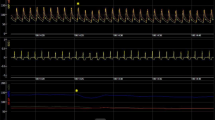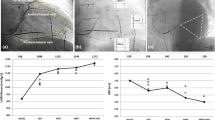Abstract
Background
To maximize the hemodynamic benefit of cardiac resynchronization therapy (CRT), echocardiographic AV interval optimization is routinely performed, complemented by VV interval optimization especially in non-responders. Programming of the basic pacing rate, however, is largely empirical in these patients. Therefore, the present study aimed to systematically evaluate the impact of basic pacing rate on hemodynamic parameters in CRT patients with sinus bradycardia.
Methods and results
We included 70 consecutive patients with moderate to severe heart failure, LV ejection fraction ≤35%, left bundle branch block or a QRS duration >120 ms combined with echocardiographic evidence of ventricular dyssynchrony. All patients were on optimal heart failure medication, with CRT-ICD devices implanted at least 6 months before inclusion into the study. All patients were in sinus rhythm with a spontaneous heart rate <40 bpm. In all patients, cardiac output (CO) and stroke volume (SV) were determined using electrical velocimetry (EV) (Aesculon, Osypka Medical, Berlin, Germany). EV provides a new algorithm to calculate CO based on variations in thoracic electrical bioimpedance, which has been recently validated. Hemodynamic measurements were performed at four different pacing rates ranging from 40 to 70 bpm. A stepwise increase in CO was encountered with increasing heart rates, reaching statistical significance when comparing 70 with 40 bpm. SV remained unchanged throughout all pacing rates.
Conclusions
In the range between 40 and 70 bpm, an increase in basic pacing rate enhances CO without reducing SV. According to this pilot study, a basic pacing rate between 60 and 70 bpm would appear reasonable.




Similar content being viewed by others
References
Abraham WT, Fisher WG, Smith AL, Delurgio DB, Leon AR, Loh E, Kocovic DZ, Packer M, Clavell AL, Hayes DL, Ellestad M, Trupp RJ, Underwood J, Pickering F, Truex C, McAtee P, Messenger J; MIRACLE Study Group (2002) Multicenter insync randomized clinical evaluation: cardiac resynchronization in chronic heart failure. N Engl J Med 346:1845–1853
Abraham WT, Hayes DL (2003) Cardiac resynchronization therapy for heart failure. Circulation 108:2596–2603
Auricchio A, Stellbrink C, Block M, Sack S, Vogt J, Bakker P, Klein H, Kramer A, Ding J, Salo R, Tockman B, Pochet T, Spinelli J (1999) Effect of pacing chamber and atrioventricular delay on acute systolic function of paced patients with congestive heart failure: The Pacing Therapies for Congestive Heart Failure Study Group: The Guidant Congestive Heart Failure Research Group. Circulation 99:2993–3001
Beck C, Osthaus A, Betram H, Suntordjo S, Wessel A (2006) Nicht-invasive Herzzeit-Volumen-Messung bei Kindern mit angeborenen Herzfehlern. Clin Res Cardiol 95(Suppl 5):A1298
Bernheim A, Ammann P, Sticherling C, Burger P, Schaer B, Brunner-La Rocca HP, Eckstein J, Kiencke S, Kaiser C, Linka A, Buser P, Pfisterer M, Osswald S (2005) Right atrial pacing impairs cardiac function during resynchronization therapy. J Am Coll Cardiol 45:1482–1487
Bernstein DP, Osypka (2003) MJ apparatus and method determining an approximation of the stroke volume and the cardiac output of the heart. US Patent 6,511,438 B2, 28 Jan 2003
Cazeau S, Leclercq C, Lavergne T, Walker S, Varma C, Linde C, Garrigue S, Kappenberger L, Haywood GA, Santini M, Bailleul C, Daubert JC (2001) Effects of multisite biventricular pacing in patients with heart failure and intraventricular conduction delay. N Engl J Med 344:873–880
Gauri AJ, Raxwal VK, Roux L, Fearon WF, Froehlicher VF (2001) Effects of chronotropic incompetence and beta-blocker use on the exercise treadmill test in men. Am Heart J 142:136–141
Kindermann M, Frohlig G, Doerr T, Schieffer H (1997) Optimizing the AV delay in DDD pacemaker patients with high degree AV block: mitral valve Doppler versus impedance cardiography. Pacing Clin Electrophysiol 20:2453–2462
Lechat P, Hulot JS, Escolano S, Mallet A, Leizorovicz A, Wehrlen-Grandjean M, Pochmalicki G, Dargie H (2001) Heart rate and cardiac rhythm relationships with bisoprolol benefit in chronic heart failure in CIBIS II trial. Circulation 103:1428–1433
O’Donnell D, Nadurata V, Hamer A, Kertes P, Mohammed W (2005) Long-term variations in optimal programming of cardiac resynchronization therapy devices. Pacing Clin Electrophysiol 28(Supp1):24–26
Schmidt G, Theilmeier G, Van Aken H, Korsmeier P, Wirtz SP, Berendes E, Hoffmeier A, Meissner A (2005) Comparison of electrical velocimetry and transoesophageal Doppler echocardiography for measuring stroke volume and cardiac output. Br J Anaesth 95:603–610
Author information
Authors and Affiliations
Corresponding author
Additional information
Dr. F. Voss and Dr. R. Becker contributed equally to this work.
Rights and permissions
About this article
Cite this article
Voss, F., Becker, R., Hauck, M. et al. The basic pacing rate in CRT patients: the higher the better?. Clin Res Cardiol 98, 219–223 (2009). https://doi.org/10.1007/s00392-009-0745-2
Received:
Accepted:
Published:
Issue Date:
DOI: https://doi.org/10.1007/s00392-009-0745-2




